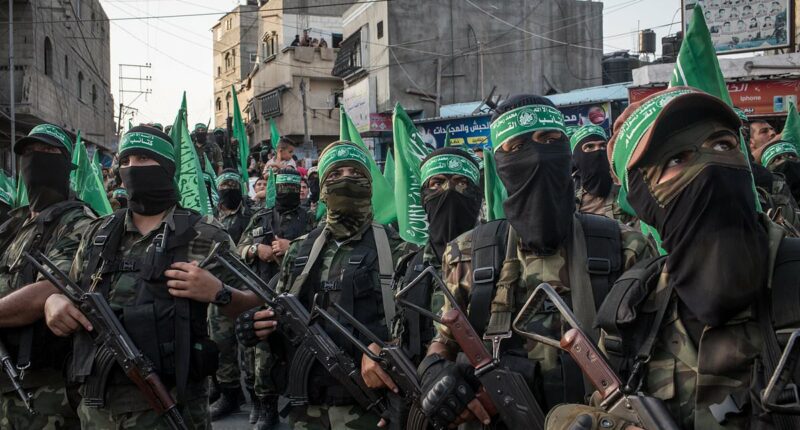Share this @internewscast.com
Two years after the violent atrocities of October 7, Donald Trump has brokered a peace deal between Israel and Hamas that may finally put an end to a devastating war.
But even as Israelis and Palestinians take to the streets of Tel Aviv and Khan Younis to celebrate the ceasefire, it remains to be seen whether the peace agreement will be lasting.
Prime Minister Benjamin Netanyahu’s cabinet voted early Friday morning in favour of the deal, after the warring parties gave assent to the first phase of Trump’s 20-point plan on Wednesday evening.
‘This means that ALL of the Hostages will be released very soon, and Israel will withdraw their Troops to an agreed upon line as the first steps toward a Strong, Durable, and Everlasting Peace,’ a jubilant US president wrote on Truth Social.
While the return of hostages after 737 days and a ceasefire ending two years of Israeli bombardment will be welcome news to either side, such steps are only the start.
The sides are yet to agree on the precise details of the second phase of Trump’s plan, which calls for the disarmament of Hamas; a transitional authority to govern the Strip; and a multinational peacekeeping force to provide security.
While Israel has demanded for the terror group to play no role in the future of Gaza and for it to lay down its weapons, the Sunni Islamist organisation hasn’t committed to either.
Meanwhile, Netanyahu has said that his military will stay ‘deep inside the Strip’ for the foreseeable future, despite the plan stipulating that Israel should withdraw from the enclave.

While Israel has demanded for the terror group to play no role in the future of Gaza and for it to lay down its weapons, the Sunni Islamist organisation hasn’t committed to either

Palestinians, including children, gathered in the city of Khan Yunis celebrate after the announcement of the ceasefire agreement in Gaza on October 9, 2025
What has been agreed?
Israel and Hamas agreed to the first phase of Trump’s plan, which includes the return of the 20 living hostages still captive in the Strip in exchange for thousands of Palestinian prisoners, and a partial IDF withdrawal from the enclave.
At midday in Israel today, the military announced a ceasefire after overnight airstrikes in Gaza City’s Sabra neighborhood caused a building to collapse, trapping some 40 people under the debris, according to Palestinian media.
The IDF began a staged withdrawal, positioning themselves ‘along the updated deployment lines’.
The Israeli military now remains in control of around 53 percent of the Strip’s territory, including a buffer zone that runs along the entire border and encompasses the Philadelphi Corridor, as well as the northern areas of Beit Hanoun and Beit Lahiya, a ridge on Gaza City’s eastern outskirts, and substantial portions of Rafah and Khan Younis in the south.
According to the agreement, the ceasefire triggers a 72-hour countdown during which all of the hostages – both the living and deceased – must be returned to Israel.
This means that Hamas has until Monday at noon to return the 20 living hostages.
The return of the bodies of the 28 deceased should follow, but it is unclear how long this will take as Hamas has previously indicated that their location is unknown.
A taskforce has been established to locate the deceased missing hostages, an official told the Daily Mail, including representatives from Israel, the US, Egypt and Qatar, who will work with forces on the ground in the enclave to find their location.
The handover of hostages will take place ‘without any public ceremonies or media coverage,’ in order to avoid the previous public spectacles Hamas engineered, including parading emaciated Israelis on stage.
Once all hostages are returned, Israel will release 250 prisoners serving life sentences and 1,700 Palestinians detained after October 7, 2023.
It will also return the remains of 15 Palestinians for every deceased Israeli hostage.
The final list of Palestinian prisoners set to be released has not been made public.
Last night, far-right National Security Minister Itamar Ben Gvir’s demand to veto the release of specific Palestinian security prisoners delayed the start of the cabinet meeting by several hours.
An Israeli government spokesperson said that the prisoners freed in the exchange will not include Marwan Barghouti, founder of the Palestinian Fatah party and a major leader in the First and Second Intifadas whose release is being sought by Hamas.
From Friday, some 600 aid trucks carrying food, medical equipment, shelter supplies, fuel and cooking gas will enter Gaza each day, and hundreds of civilians will begin to return to their homes in the north.
The United States will deploy a multinational, 200-strong task force of troops to Israel to support stabilisation efforts in Gaza, comprised of personnel from Egypt, Qatar, Turkey and the United Arab Emirates.

Palestinians gathered at the Nuseirat refugee camp celebrate with flags in Deir al-Balah, Gaza, on October 9, 2025

Israelis celebrate as they react to the news of the Gaza peace deal at Hostages Square on October 9 in Tel Aviv, Israel

Itzik Horn, father of kidnapped Eitan Horn (L), celebrates after a peace deal is announced at Hostages Square in Tel Aviv, Israel, October 9, 2025

Palestinians, including children, gathered in the city of Khan Yunis celebrate after the announcement of the ceasefire agreement in Gaza on October 9, 2025
What happens next?
If the first phase is completed, negotiations will begin over next stage of the peace process, which doesn’t yet have a strict timeline or deadlines.
According to Trump’s 20-point plan, the next phase involves Hamas fighters decommissioning their weapons, with all ‘military, terror and offensive infrastructure’ in the Strip being destroyed, making it a ‘terror-free zone’.
Militants will be offered amnesty if they commit to peaceful co-existence with Israel, and will be provided safe passage to another country if they choose to leave.
Meanwhile, a transitional technocratic committee made up of Palestinians and international experts is to run Gaza, with oversight provided by a new international ‘Board of Peace’ chaired by Trump himself.
An international panel of experts will create a plan for Gaza’s economic redevelopment, and a special economic zone will be established.
Hamas will not take part in Gaza’s governance, according to the plan, and the Palestinian Authority, based in the Israeli-occupied West Bank, will have to enact reforms before it might assume power.
Eventually, the conditions may be in place for a pathway to Palestinian self-determination and statehood.
No one will be forced to leave Gaza, and those who wish to leave will be free to do so and free to return.

Israeli tanks arrive at a gathering site after withdrawing from the Gaza Strip following the Israel-Hamas agreement on the first phase of the Gaza peace plan, near the Israeli-Gaza border in southern Israel, 10 October 2025

Smoke rises from the area after Israeli airstrikes targeted areas in the Gaza Strip on October 9, 2025

Some Palestinians walk on foot along Rashid Street, carrying the few belongings they manage to save, as they hope to go back to their homes after enduring harsh living conditions for months in Gaza City on October 10, 2025
What could hold up the later phases?
The major areas likely to hold up the peace process include the disarming of Hamas, the group’s future involvement in the government of Gaza, and Israel’s willingness to withdraw from the Strip.
The White House plan indicates further withdrawals of Israeli troops to around 40 per cent and then 15 per cent, with a final stage concluding in a ‘security perimeter’ that would ‘remain until Gaza is properly secure from any resurgent terror threat’.
This means there is no set timeline dictating when troops must fully withdraw, contradicting a key tenet in Trump’s plan that calls on Israel to ‘not occupy’ Gaza.
Meanwhile, Hamas has not committed to either disarming or abandoning its political future in the Strip.
In a letter to Trump provisionally accepting the first phase of the deal, the terror group said it was committed to being part of a ‘comprehensive Palestinian national framework’ – indicating a future in the enclave.
Officials have also previously refused to disarm until an independent Palestinian state is established.
And while the Trump deal calls for the war to ‘immediately end’, Netanyahu has already threatened Hamas with the resumption of military hostility if conditions are not met in the ‘easy way’.
‘Hamas will be disarmed, and Gaza will be demilitarised,’ he said in a press conference on Friday.
‘If this is achieved the easy way, great. And if not, it will be achieved the hard way.’







